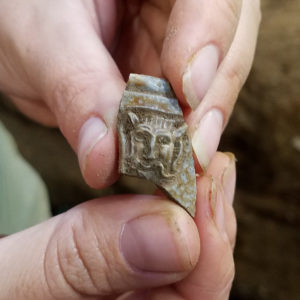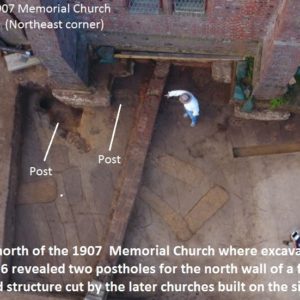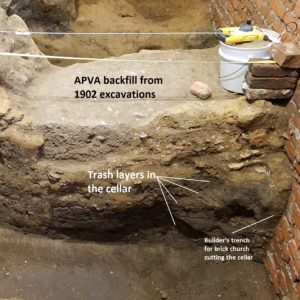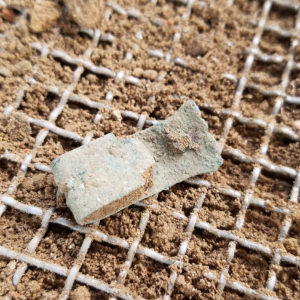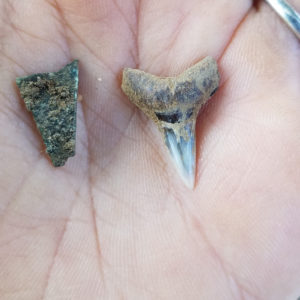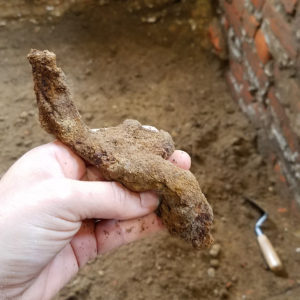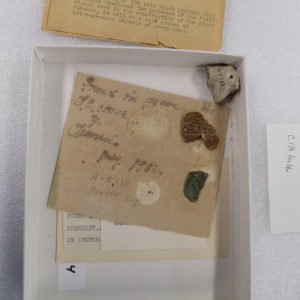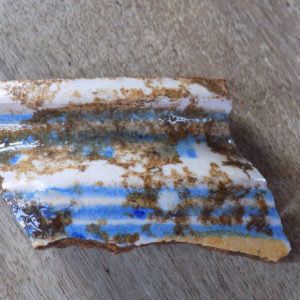When Rediscovery archaeologists began excavating in the east end of the 1907 Memorial Church in the fall of 2016, they uncovered an unexpected assortment of artifacts that were atypical of church-related material. The backfill left by Association for the Preservation of Virginia Antiquities (APVA, today Preservation Virginia) excavators in the early 20th century contained numerous early 17th-century artifacts, typical of early fort period material culture. Rediscovery archaeologists speculated that the earlier excavators may have uncovered more than the surviving brick and tile floors of the three 17th-century churches and the graves hidden beneath.
“Much of the area that we’ve excavated within James Fort was littered with fort period artifacts. However, the large number of early ceramics, scrap copper, glass beads, and military-related artifacts we encountered in the church surprised us,” said Project Archaeologist Mary Anna Hartley. “These artifacts are classic indicators of backfilled cellars or pits dating to the early James Fort period.”
The recovery of so much early material suggested that an artifact-rich feature pre-dating the first church may have been in this location. In fact, in 2016, excavations outside the northeast corner of the 1907 Memorial Church revealed two postholes that presumably were part of a post-in-ground structure. Since no additional evidence of the structure was uncovered, it was thought that it probably extended to the south, and that it had been disturbed or destroyed during later church construction and also by burials.
After placing two tests in the east end of the church and removing some of the 20th-century backfill during current excavations, a portion of a feature with stratified soil layers was discovered. Examination of the profile of these intact layers revealed that the feature was cut by chancel burials and also by the east wall of the 1640s church. The early 17th-century artifacts found in the APVA backfill had undoubtedly originated from this cellar or pit, or from the chancel graves that cut into it!
Among the numerous artifacts found this season were military-related items, including an iron sword hanger from a belt that held a sword, the hilt of an iron left-handed dagger, and an iron falconet, or cannonball. In addition, numerous Venetian glass beads, a copper book clasp and scrap copper, and glass case bottle fragments were recovered. If a Harrington farthing (c. 1613) found in the east end of the church came from the cellar/pit, it likely means that that feature was filled in the teens, just before the 1617 Church was built over it.
A small graphite fragment was also found. Graphite was a rare commodity at Jamestown, and is only found in Jamestown’s earliest features. Two fossil shark’s teeth were uncovered—one from a megalodon! They were likely collected as curiosities by colonists who explored the local beaches. Sherds of Surrey-Hampshire Border ware, Frechen brown saltglazed stoneware, delftware, and Westerwald saltglazed stoneware are among the numerous early ceramics from the backfill.
“One sherd is unique in our collections. It is from a wide-mouth jug made in Frechen, Germany, possibly as early as the late 16th century. Unlike our numerous Bartmann jugs that bear the face of a bearded man, it is ornamented with a lion’s mask,” said Curator Merry Outlaw.
The APVA excavators recorded that they had recovered artifacts in many of the graves in this location during their 1901-1902 excavations. When Outlaw and Hartley re-examined the small assemblage and read their handwritten notes describing where in the church they were found, there was little doubt that many came from the recently recognized cellar or pit.
In the 1902 report of the Jamestown Subcommittee, Mary Winder Garrett described a grave dug in the Southeast corner of the church. She penned that: “In this grave were found the usual number of nails, one of which was very large, a piece of frail corroded metal, probably a piece of a coin, a small lead or pewter candlestick or sconce.” Understandably, objects she described were hard to identify. Still preserved in the Rediscovery collections, the so-called “small lead or pewter candlestick” is, in fact, the ca. 1615 cap of a bandolier that held a proper measure of gun powder.
related images
- Archaeologists Leah Stricker and Bob Chartrand express their excitement about the discovery of a megalodon tooth in the 20th-century backfill in the church chancel area
- A sherd of a wide-mouth jug made in Frechen, Germany ornamented with a lion’s mask
- Area north of the 1907 Memorial Church where excavations in 2016 revealed two postholes for the north wall of a fort-period structure cut by the later churches built on the site.
- Postholes outside the northeast corner of the Memorial Church
- Features in the church floor
- Copper book clasp
- A piece of scrap copper and a shark’s tooth found in the church. Both are likely from the cellar/pit.
- Harrington farthing obverse and reverse
- A dagger hilt found in the east end of the church
- The bottom base to a glass case bottle, found in the APVA excavation backfill, was likely originally deposited in the cellar/pit.
- A lead cap from a bandolier cylinder, a fragment of iron plate, and copper scrap were found by the APVA excavators in 1902
- Part of the rim for a delft drug jar that was found in the APVA backfill. This fragment likely originated from the cellar or pit under the churches.
- Bob Chartrand cleans the profile of a large cellar/pit feature in the eastern end of the church following the removal of some of the early 20th-century excavation backfill.




